Fall Mushroom Foraging: How to Forage Fall Fungi & Edible Wild Mushrooms
Fall is a magical time of year when nature has a stunning transformation. While many people appreciate the beauty of this season, some of us eagerly anticipate it for another reason – the opportunity to forage for wild mushrooms! Fall mushrooms, also known as autumn fungi, make their appearance during this time, offering an array of flavors and textures to culinary enthusiasts and nature lovers. In this comprehensive guide, we'll explore the art of fall mushroom foraging, teaching you how to identify, harvest, and savor these delicious fungi safely! My number one tip for fall foraging is “when in doubt, throw it out!”. It’s never worth the risk of consuming a poisonous mushroom. Let’s start with the basics of some of my favorite fall mushrooms:
Oyster Mushrooms: Delicate and Delicious
Oyster mushrooms (Pleurotus ostreatus) are some of the most sought-after fall mushrooms due to their exquisite taste and versatility. These mushrooms are easily recognizable by their fan-shaped caps and soft gills, which descend the stem. They typically grow on dead or dying hardwood trees and can be found in clusters. Oyster mushrooms are a great choice for beginners, but they do have a few poisonous look-alikes.

Chicken of the Woods Mushrooms: A Vegetarian Delight
Chicken of the Woods (Laetiporus sulphureus) is a striking mushroom with vibrant orange and yellow hues. Its taste and texture are reminiscent of chicken, making it a popular choice for vegetarians and vegans seeking a meaty alternative. You can often find Chicken of the Woods growing on the trunks of hardwood trees, such as oaks. However, always be cautious and avoid harvesting specimens growing on conifers, as they can cause digestive issues.
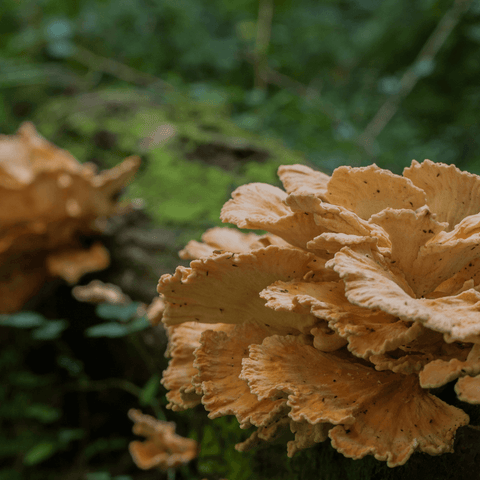
Hen of the Woods Mushrooms: A Wild Culinary Treasure
The Hen of the Woods (Grifola frondosa), also known as Maitake, is a favorite among mushroom hunters for its hearty and meaty texture. These mushrooms are usually found at the base of hardwood trees, particularly oaks. Hen of the Woods forms large, leafy clusters that resemble a hen's plumage, hence its name. They are among the most well-known fall mushrooms and are prized for their delicious flavor.

Chanterelles: The Golden Jewels of Autumn
Chanterelles (Cantharellus cibarius) are renowned for their rich, nutty flavor and distinctive appearance. These golden mushrooms have smooth, vase-shaped caps with wavy edges and false gills underneath. Chanterelles are often found near oak trees, and their vibrant color makes them relatively easy to spot. Their scarcity and culinary value have earned them the nickname "the jewels of the forest."
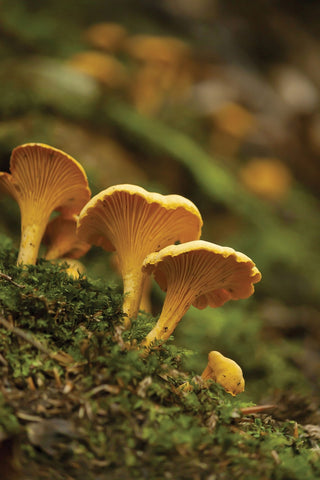
Honey Mushrooms: Abundant and Versatile
Honey mushrooms (Armillaria mellea) are one of the most commonly encountered fall mushrooms. They grow in large clusters on hardwood trees and stumps, presenting an unmistakable sight in the woods. Although some honey mushrooms are edible and delicious, it's essential to note that there are several species within the Armillaria genus, and not all of them are safe for consumption.
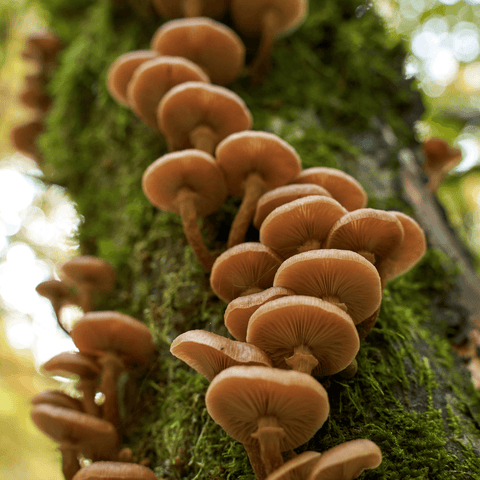
Puffball Mushrooms: A Unique Delicacy
Puffball mushrooms are intriguing members of the mushroom kingdom. These fall mushrooms are known for their spherical or pear-shaped appearance, often resembling a white or cream-colored ball. Unlike many mushrooms, puffballs lack gills, making them easy to identify. When sliced open, a puffball should reveal a pure white, firm interior – this is the edible part. Puffballs are revered for their mild flavor and tender texture, making them perfect for various culinary creations. However, it's crucial to harvest puffballs when they are young and still completely white. Once they begin to mature and turn yellow, the interior may transform into spores, rendering them inedible.
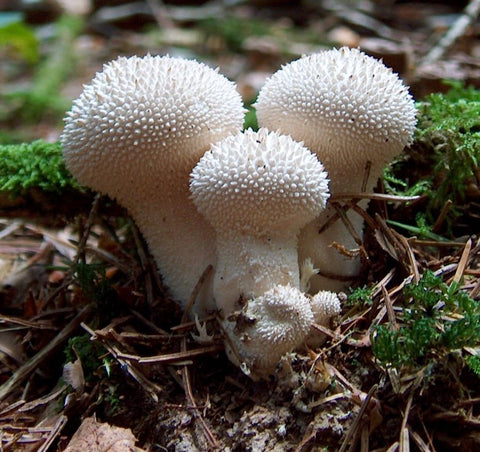
Lobster Mushrooms: Nature's Hidden Treasure
Lobster mushrooms are named for their vibrant, reddish-orange appearance, resembling the shell of a lobster. However, these mushrooms are not a single species but rather the result of a unique parasitic relationship between a fungus and a host mushroom. The host mushroom, usually a gilled variety, becomes completely engulfed by the lobster fungus, altering its color and texture. The result is a visually stunning mushroom that stands out amidst the fall foliage. Lobster mushrooms are sought after for their firm texture and earthy, nutty flavor. They are versatile and can be used in a wide range of dishes, from soups to stir-fries, imparting a rich, umami taste.

Mane Mushrooms: Lion's Mane for Brain Health
Lion's Mane mushrooms, often referred to simply as "mane mushrooms," are unique in both appearance and potential health benefits. These fall mushrooms look like cascading white icicles and have earned a reputation for their potential cognitive-boosting properties. Some studies suggest that Lion's Mane may support brain health and help prevent dementia. Beyond their potential medicinal value, mane mushrooms are delectable and possess a delicate seafood-like flavor. They can be cooked in various ways, including sautéed, grilled, or used as a meat substitute in vegetarian dishes, making them a valuable find for both your palate and well-being.
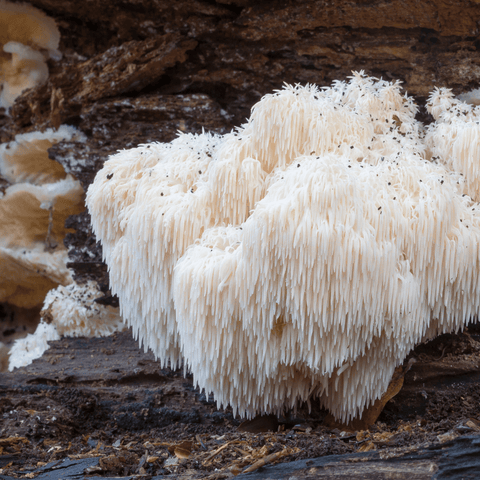
Black Trumpet Mushrooms: Hidden Gems in the Woods
Black trumpet mushrooms, with their dark, funnel-shaped bodies, are often hidden gems in the forest. These fall mushrooms are highly prized for their rich, smoky flavor and are known to add depth to culinary creations. They are often found in clusters on the forest floor, amid fallen leaves and decaying matter. Due to their dark color, a keen eye is required to spot them, but the reward is well worth the effort. Black trumpets are used in various dishes, from savory sauces to delicate pasta recipes, and their unique, aromatic essence sets them apart in the world of foraging.
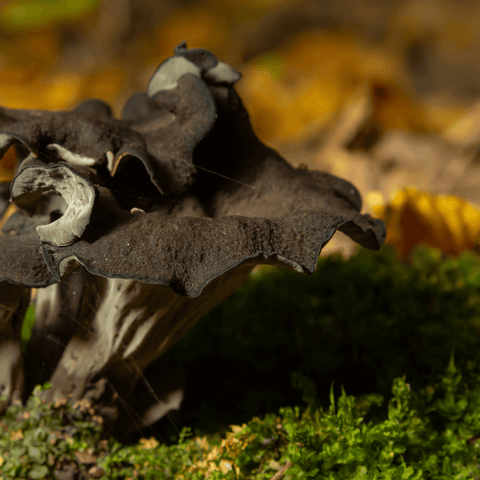
Morel Mushrooms: Nature's Delicious Puzzle
Morel mushrooms are an iconic and highly coveted species among foragers. These spring up in the early fall and are celebrated for their distinctive, honeycomb-like appearance. Morels have a rich, earthy flavor and a meaty texture, making them a gourmet delight. The challenge with morels lies in their identification and location. They often blend seamlessly with their surroundings, requiring a keen eye to spot them. Morel enthusiasts typically guard their secret spots closely, and the thrill of discovering these elusive mushrooms adds to the allure of morel foraging.
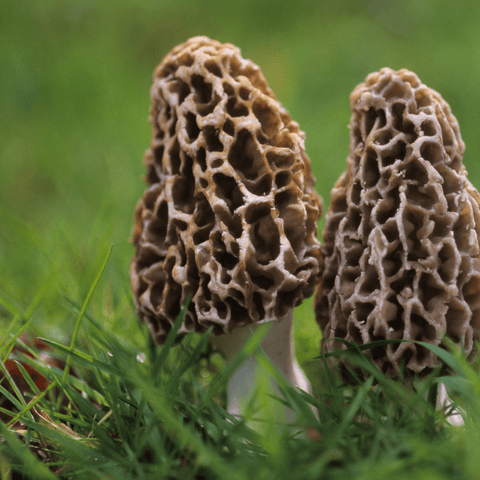
Giant Puffball: A Marvel of Mushroom Kingdom
The giant puffball mushroom is a true marvel in the world of fungi. As the name suggests, these fall mushrooms can grow to impressive sizes, sometimes reaching the dimensions of a soccer ball or larger. What sets giant puffballs apart is their pristine white appearance and the absence of gills. When you slice into a giant puffball, you'll find a solid white interior that is the edible part of this mushroom. It has a mild flavor and a texture reminiscent of tofu, making it versatile for various culinary applications. It's important to note that, like smaller puffballs, giant puffballs should be harvested when they are young and before they begin to develop spores inside, which can affect their taste and edibility. These massive mushrooms can be prepared in various ways, from sautés to fritters, offering a unique gastronomic experience.
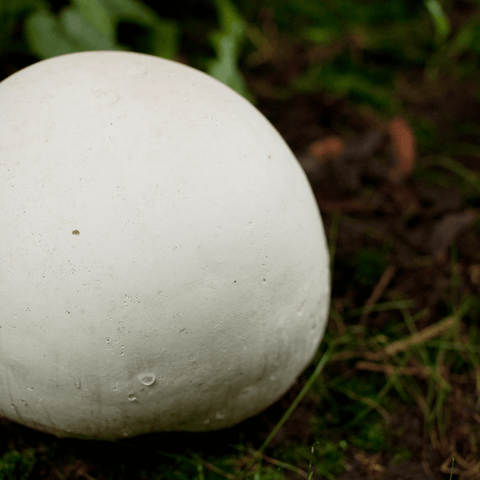
Challenges in Mushroom Identification
Fall mushroom foraging presents a significant challenge – the need to differentiate between edible and poisonous species. Here are some of the common challenges and tips for safe identification:
Look-Alike Species: Identifying Poisonous Mushrooms
One of the primary difficulties in fall mushroom foraging is distinguishing between edible mushrooms and their toxic counterparts. For instance, the Amanita genus includes the infamous Death Cap mushroom, which can be deadly if consumed. To avoid mistakes, take the time to study and accurately identify species in your area. A comprehensive field guide is an indispensable tool for mushroom identification.
The Role of Field Guides in Identification
A reliable field guide is your best friend in mushroom hunting. Look for a guidebook specific to your region or the locations you intend to forage. These guides provide detailed information on various mushroom species, including their physical characteristics, habitats, and edibility. When in doubt, always cross-reference your findings with the field guide to confirm the identity of a mushroom.
Common Mistakes in Mushroom Hunting
Novice foragers often make errors in judgment, which can lead to dangerous situations. Some common mistakes include:
- Overconfidence: Assuming that you can identify all mushrooms correctly.
- Ignoring Field Guides: Neglecting the valuable information found in field guides.
- Disregarding Safety: Failing to take safety precautions seriously, such as notifying someone of your foray and carrying a first aid kit.
Mistakes can be costly, so always exercise caution and prioritize safety when foraging. When in doubt, throw it out!
Where to Find Fall Mushrooms to Forage
Hardwood Trees: The Preferred Habitat
Fall mushrooms, such as oyster mushrooms, Chicken of the Woods mushroom, and Hen of the Woods mushroom, have a strong affinity for hardwood trees. These trees, which include oak, maple, and beech, serve as the primary host for many sought-after species. When foraging, concentrate your efforts near these hardwood giants for the best results.
Oak Trees and Beyond: Prime Mushroom Spots
Oak trees, in particular, are known to host a diverse range of edible mushrooms, including Chanterelles and Hen of the Woods. However, don't limit your search to oaks alone. Other hardwood trees, such as maples and beech, can also yield fruitful results.
Mushroom Foraging Equipment
The Basics: Basket, Knife, and Field Guide
When embarking on a mushroom foraging adventure, you'll need some essential equipment. These include a basket or foraging bag to collect mushrooms, a knife for cutting them cleanly from their stems, and a reliable field guide for identification. Always carry these tools to enhance your foraging experience.
Dressing for Success: Appropriate Attire
Proper attire is crucial when mushroom foraging. Wear sturdy, comfortable clothing that can withstand the elements, including mud and thorns. Boots with good traction are essential, especially when navigating uneven terrain. Additionally, consider donning a hat and bringing rain gear in case of unexpected downpours.
Safety Essentials: First Aid Kit and Communication
Safety should always be a top priority during mushroom foraging. Carry a basic first aid kit and a means of communication, such as a cell phone or a two-way radio. Ensure someone knows your whereabouts and expected return time. While foraging is generally safe, being prepared for unforeseen circumstances is wise.

Fall Mushroom Hunting Techniques
Scouting for Clusters: A Sign of Abundance
When foraging for mushrooms, keep an eye out for clusters of fungi. In the fall, many species grow in groups, making them easier to spot. These clusters can sometimes be quite extensive, providing you with a bountiful harvest. However, be selective in your harvest, leaving some mushrooms to ensure their future growth.
The Art of Patient Observation
Mushroom hunting is not a race. Take your time to carefully observe the environment and look for subtle signs of mushroom presence. Often, you'll notice a variety of mushrooms as you explore the woods. By observing their location, you can develop a better understanding of their habitat preferences.
Harvesting Mushrooms with Care
When it's time to harvest a mushroom, do so with care. Use a sharp knife to cut the mushroom near its base, leaving the mycelium (the mushroom's "root") intact. This practice ensures the continued growth of mushrooms in the area. Avoid damaging the surrounding environment and follow the "Leave No Trace" principles when foraging.
Mushroom Poisoning: Recognizing the Dangers
Identifying Poisonous Mushrooms
Mushroom poisoning can have severe consequences, which is why it's vital to be able to identify potentially toxic species. Common poisonous mushrooms include the Amanita family, which includes the Death Cap and Destroying Angel mushrooms. When in doubt, err on the side of caution and never consume a mushroom unless you are absolutely certain of its identity. When in doubt, throw it out.
Symptoms of Mushroom Poisoning
Mushroom poisoning can lead to a range of symptoms, including nausea, vomiting, abdominal pain, and even organ failure in severe cases. If you suspect mushroom poisoning, seek medical attention immediately. Do not wait for symptoms to worsen, as early intervention can significantly improve the outcome.
What to Do If Poisoning Occurs
If someone you are foraging with or you yourself experience symptoms of mushroom poisoning, take the following steps:
-
Seek Medical Help: Call 911 or your local emergency number immediately.
-
Collect Samples: If possible, retain a sample of the mushroom ingested for identification. This will assist healthcare professionals in determining the best course of treatment.
-
Do Not Delay: Don't wait for symptoms to worsen. Early intervention is crucial in mushroom poisoning cases.
Culinary Delights: Cooking with Fall Mushrooms
Mushroom Recipes to Savor
Once you've successfully foraged your fall mushrooms, it's time to enjoy the culinary delights. There are countless recipes to explore, from simple sautés to gourmet dishes. Some popular mushroom dishes include mushroom risotto, cream of mushroom soup, and stuffed mushrooms. Get creative in the kitchen and let the flavors of your freshly foraged mushrooms shine. Check out our Living Wilder Fall Foraging episode for some great recipes.
Preserving the Fruits of Your Foraging
Mushroom foraging often yields more than you can consume immediately. To enjoy your finds throughout the year, consider preserving them. Common preservation methods include drying, pickling, and canning. Properly preserved mushrooms can be used in a variety of recipes, even after the foraging season has ended.
Culinary Creativity with Wild Mushrooms
One of the joys of fall mushroom foraging is the opportunity to experiment with new flavors and textures in your dishes. The unique taste of each species can elevate your culinary creations. Embrace the challenge of working with wild mushrooms, and let your creativity run wild in the kitchen.
The Future of Fall Mushroom Foraging
Sustainability in Mushroom Foraging
As more people become interested in mushroom foraging, it's crucial to maintain the sustainability of this practice. Harvest responsibly, leaving some mushrooms behind to allow for their natural reproduction. Always respect the environment and the organisms within it.
Role in Promoting Conservation
Mushroom foraging can also play a role in promoting conservation. By learning more about the ecosystems and habitats in which mushrooms grow, foragers can become advocates for the protection of these environments. A healthy forest is essential for the continued growth of mushrooms.
The Adventure Continues: Your Next Foray
Mushroom foraging is a lifelong learning experience. Every season, every forest, and every mushroom is unique. As you continue your journey, you'll develop a deeper connection to nature and a more profound appreciation for the incredible world of fungi. So, prepare for your next foray, explore new regions, and keep the adventure alive.
Living Wilder Nature Series: Urban Mycology Episode
For those seeking to further their knowledge and appreciation of the wild world of fungi, don't miss Episode 2 of The Urban Botanist's "Living Wilder Series." In this captivating episode, the spotlight shines on Ontario's Amherst Island, where I, Emma Terrell, embark on a fascinating journey with Ruthie Cummings to uncover indigenous edible species of plants and fungi. It's a remarkable exploration of nature, local foraging, and fungi recipes. You can watch the full episode on urban mycology by following this YouTube link.
In Summary
Fall mushroom foraging is a delightful way to connect with nature, explore the delicious world of wild fungi, and embrace the vibrant beauty of autumn. By understanding the different species, learning to identify them safely, and practicing sustainable foraging, you can savor the culinary treasures that nature provides. Remember to prioritize safety, respect the environment, and share your knowledge and experiences with fellow foragers. With each successful harvest, you'll gain a deeper appreciation for the enchanting world of fall mushrooms. So, gear up, venture into the woods, and embark on your own mushroom foraging adventure – the forest awaits, with its delicious secrets waiting to be uncovered. Happy foraging!
